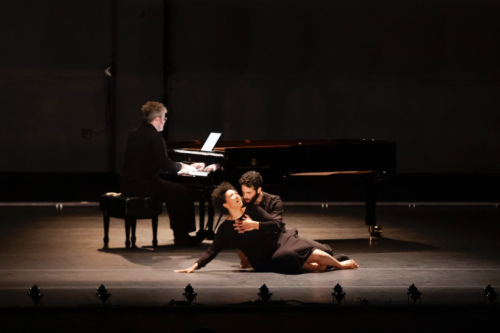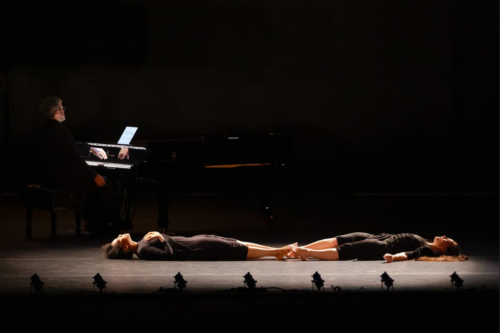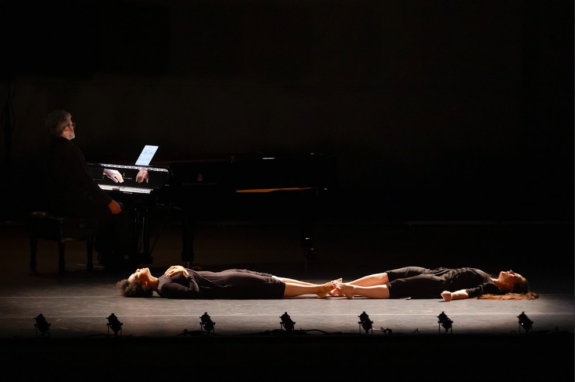 United States Messiaen, Harawi: Julia Bullock (soprano), Conor Hanick (piano), American Modern Opera Company. Presented by Cal Performances, Zellerbach Hall, University of California Berkeley, 27.9.2024. (HS)
United States Messiaen, Harawi: Julia Bullock (soprano), Conor Hanick (piano), American Modern Opera Company. Presented by Cal Performances, Zellerbach Hall, University of California Berkeley, 27.9.2024. (HS)

Production:
Director – Zack Winokur
Choreographers & Dancers – Bobbi Jene Smith, Or Schraiber
Lighting – John Torres
Sound – Mark Grey
Costumes – Victoria Bek
Soprano Julia Bullock opened the Cal Performances’ 2024 season with a musically rewarding and visually compelling take on Harawi, Olivier Messiaen’s 1946 song cycle for soprano and piano, set to his own surrealist libretto. In her first presentation as the newly minted artist-in-residence for Cal Performances, she headlined the thoughtful staging that she conceived with the American Modern Opera Company (AMOC) and had premiered at the Aix-en-Provence Festival in July 2022. Adding two dancers, who interact with the singer and pianist, expands on the Tristan und Isolde-inspired imagery embedded in the hour-long cycle of twelve songs.
This was the United States premiere, after performances last year in Antwerp, Leverkusen and Hamburg (to be followed by further performances in Beverly Hills and Santa Barbara).
Subtitled ‘Chant d’amour et de mort’ (‘A song of love and death’), the piece uses elements, literally and symbolically, of the South American folk song genre called ‘Harawi’ – music that is still part of diverse cultures in Peru, Chile, Bolivia, Ecuador and beyond. Bullock deployed her flexible, soft-edged soprano and sure-footed musicality to deliver, in a clear light, melodies that embodied the exotic nature of these sources. The words were projected on an oversized screen above the back of the stage in French or Quechuan above an English translation (except for some nonsense words intend for their sound).
Pianist Conor Hanick, who premiered Samuel Carl Adams’s piano concerto with the San Francisco Symphony last year and has performed regularly with Bullock, brought Messiaen’s signature piano sound to life brilliantly. He made the composer’s harmonic clusters dance effortlessly and delivered the rhythms with clarity. Much of the score gets its flavor and spice from the piano. It all came through and found welcome balances with Bullock.
Messiaen started writing this piece in 1945, shortly after being released from a war prison. Tragically, the mind and body of his wife, Claire Delbos, a fellow musician and a source of inspiration, had begun to deteriorate, eventually ending in total amnesia. Before long a new love partner was entering his life. No wonder Tristan und Isolde caught his attention, with its besotted (and extramarital) lovers.
Messiaen found reflections of grief over his wife’s decline and metaphors for his budding new love in the borrowed Quechuan songs and in his own French ones, expressing highly symbolized memories and dreams.
The dance, directed by Zack Winokur and choreographed by Bobbi Jene Smith and Or Schraiber, amplified the songs by expressing emotions and memories rather than a specific narrative, although it did pair both dancers with Bullock at different times. The lithe and expressive dancers often leaned against or draped themselves around Bullock as she sang.

At one point, as Bullock lay on her back for several minutes while singing beautifully, dancer Smith also laid flat, like a reflection of her, foot-to-foot – a nice visual representation of the connection between dance and the songs. Another time. Schraiber glided smoothly up to face Bullock and coaxed her into a slow ballroom dance. Throughout the performance, Bullock, clad in a form-fitting black gown and barefoot, as were the dancers, moved with elegance and at times with the sinuousness of the dancers.
If Bullock’s singing and Winokur’s execution of Messiaen’s unique music world were foremost, the rest of the strong effect came from the simple, all-black costumes and the dancing. With John Torres’s simple lighting finding focus on the large stage, it all added up to a palpable sense of longing and grief, and even a bit of joy in the budding romance, all wrapped in a unique combination of surrealism and dreams.
Harvey Steiman
